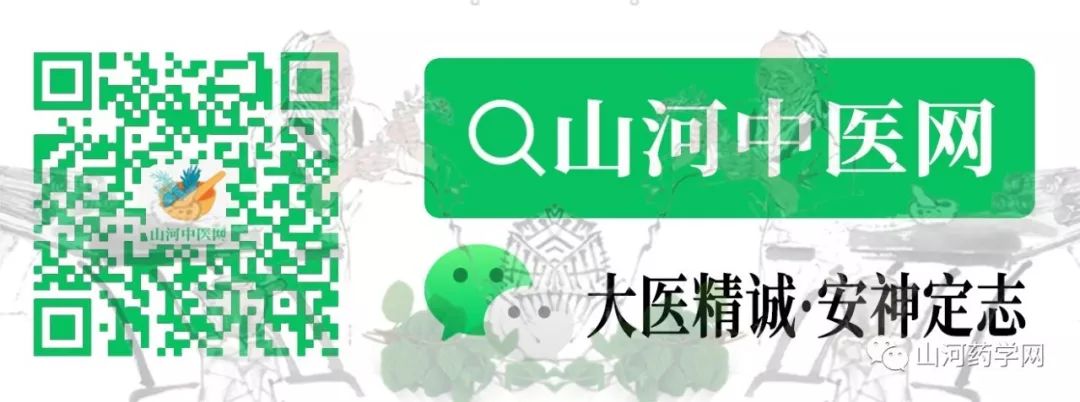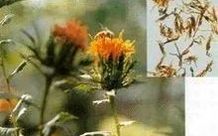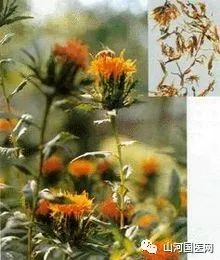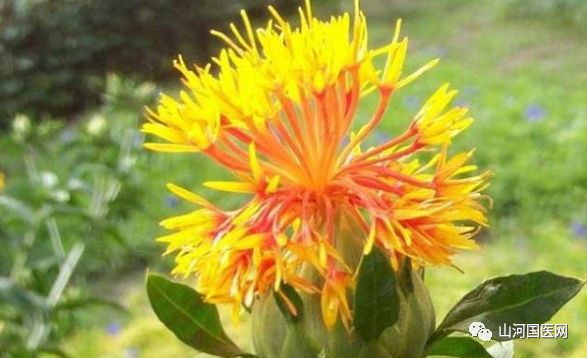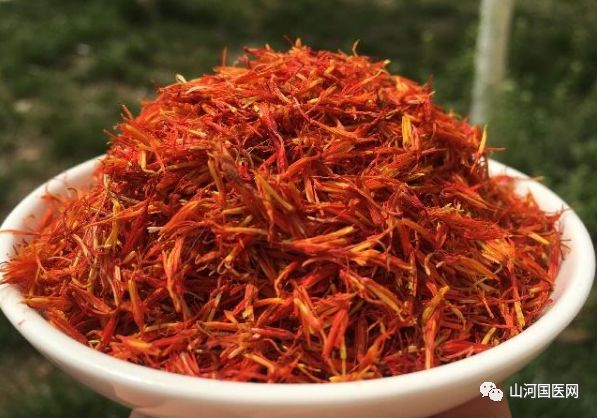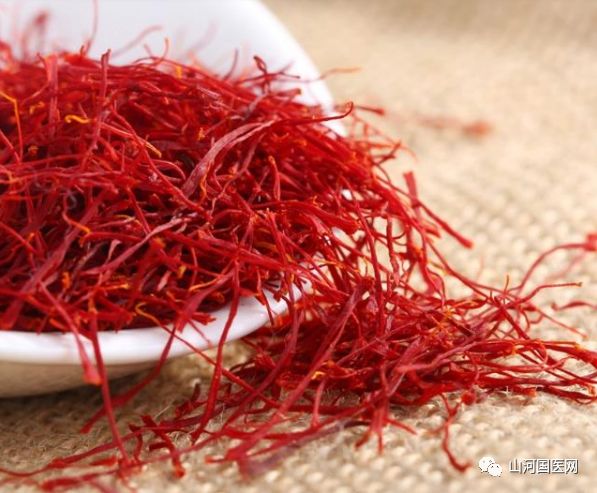| Safflower Hónɡ Huā | |
|---|---|
|
|
|
| Alias | Grass Safflower, Red Blue Flower, Spiny Safflower |
| Functions | Invigorates blood and regulates menstruation, disperses stasis and alleviates pain. Used for amenorrhea, dysmenorrhea, retained lochia, abdominal masses, traumatic injuries, and painful swellings. |
| First Recorded In | Bencao Tujing |
| Toxicity | Non-toxic |
| Meridian Affinity | Heart Meridian |
| Nature | Warm |
| Taste | Pungent |
[Source] Newly Revised Materia Medica.Alias: Grass Red, Spiny Red Flower, Du Red Flower, Golden Red Flower.Product Names:Du Red Flower:Produced in Ningbo, Zhejiang, of good quality.Huai Red Flower:Also known as Huai Red Flower, produced in Wenxian, Qinyang, Wuzhi, and Mengxian areas (formerly Huaiqing Prefecture), also of good quality.San Red Flower:Produced in Shangqiu, Henan, also of good quality.Da San Red Flower:Produced in Shandong.Chuan Red Flower:Produced in Sichuan.Nan Red Flower:Produced in southern China (some say from Nanchong, Sichuan).Xi Red Flower:Produced in Shaanxi.Yun Red Flower:Produced in Yunnan.All are best when the flowers are bright red or yellow, fresh, dry, and soft in texture.Red Flower Cake:Also known as Sliced Red Flower, made from fresh safflower pounded into a paste, spread into thin slices, and dried for medicinal use.Source: The tubular flowers of the Asteraceae plant, safflower.Widely cultivated across the country.Harvested in summer when the flowers are orange-red, then dried in the shade, sun, or by baking.Characteristics: Tubular flowers are 1-2 cm long, with a surface that is red-yellow or red; the flower crown tube is slender, with 5 lobes at the tip, lobes are narrow and 5-8 mm long; there are 5 stamens, the anthers are fused into a tube, white in color; the style is slender and cylindrical, with a slightly bifurcated tip.Soft texture.Has a faint fragrance and a slightly bitter taste.Chemical Components: Contains safflower glycosides, new safflower glycosides, safflower quinone glycosides, safflower polysaccharides, palmitic acid, cinnamic acid, and lauric acid.Nature and Taste: Warm in nature, pungent in taste.Functions and Indications: Invigorates blood and regulates menstruation, disperses stasis and alleviates pain. Used for amenorrhea, dysmenorrhea, retained lochia, abdominal masses, traumatic injuries.In ancient times, it was common to add a small handful of safflower when there was blood stagnation in the body: wrap in gauze and boil, can be used for foot baths twice a day, suitable for various varicose veins, peripheral neuritis, and blood circulation issues.Legs and feet numbness or purplish discoloration due to stasis.NotesThe fruit is called Bai Pingzi, containing “safflower seed” oil, which can lower cholesterol and high blood lipids; soften and dilate blood vessels, prevent aging, and regulate endocrine.Medicinal Safflower:[Source] This product is the dried flower of the Asteraceae plant, safflower.[Herb Characteristics] Flowers often cluster into irregular clumps.Red or red-yellow.Single flowers are about 1.5 cm long.The flower crown tube is slender, with 5 lobes at the tip, lobes are narrow and 5-7 mm long.There are 5 stamens, the anthers are fused into a tube, yellow in color.The style is long and cylindrical with a slightly bifurcated tip.Soft texture.Has a distinctive fragrance and a slightly bitter taste.When soaked in water, the water turns golden yellow, and the flowers do not fade.[Dosage] Internal use:Decoction, 3-10 g.To nourish blood and harmonize blood, use less; to invigorate blood and dispel stasis, use more.[Functions and Indications] Invigorates blood and regulates menstruation, disperses stasis and alleviates pain, used for amenorrhea, dysmenorrhea, retained lochia, abdominal masses, traumatic injuries, and painful swellings.[Notes] Use with caution in pregnant women.[Verification]:From Bencao Tujing: “Red Blue Flower, that is Safflower. Now it is found everywhere. People plant it in their gardens, sowing seeds in the winter in prepared soil, seedlings grow in spring, flowers bloom in summer, and the plant is prickly, with the flower pistils emerging from the prickles, harvested by gardeners when dew is present, and after harvesting, it regrows until the end of the season.”Seeds are white, about the size of small beans.The flowers are dried to dye true red and used to make rouge.It is mainly used for postpartum blood disorders.Its leaves resemble blue, hence the name blue.From Bencao Shuguoyuan: “Red Blue Flower, nourishes blood when boiled in water, breaks blood when cooked in wine.”【Indications】:Amenorrhea;Dysmenorrhea;Postpartum stasis abdominal pain;Chest pain due to stasis;Traumatic injuries;Joint pain;Stroke paralysis;Purplish rashes.
Verification
1. From Bencao Tujing: Red Blue Flower, that is Safflower. Now it is found everywhere. People plant it in their gardens, sowing seeds in the winter in prepared soil, seedlings grow in spring, flowers bloom in summer, and the plant is prickly, with the flower pistils emerging from the prickles, harvested by gardeners when dew is present, and after harvesting, it regrows until the end of the season. Seeds are white, about the size of small beans. The flowers are dried to dye true red and used to make rouge. It is mainly used for postpartum blood disorders. Its leaves resemble blue, hence the name blue.2. Bencao Shuguoyuan: Red Blue Flower, nourishes blood when boiled in water, breaks blood when cooked in wine.
Indications
Amenorrhea;Dysmenorrhea;Postpartum stasis abdominal pain;Chest pain due to stasis;Traumatic injuries;Joint pain;Stroke paralysis;Purplish rashes.
Contraindications
Use with caution in pregnant women.
Selected Formulas
1. Safflower Wine Formula (Jinkui Yaolue), has the function of invigorating blood and promoting circulation, relieving qi and alleviating pain.2. Peach Blossom Four Substance Decoction (Yizong Jinjian), nourishes blood, invigorates blood, and dispels stasis.3. Xuefu Zhuyu Decoction (Yilin Gai Cuo), invigorates blood and dispels stasis, promotes qi and alleviates pain, indicated for blood stasis in the chest, poor blood circulation, chest pain, and persistent headaches.4. Tongqiao Huoxue Decoction (Yilin Gai Cuo), invigorates blood and opens the orifices, indicated for stasis obstructing headaches and dizziness, or vitiligo, as well as women’s blood deficiency.5. Shentong Zhuyu Decoction (Yilin Gai Cuo), invigorates blood, promotes qi, dispels stasis, and alleviates pain, indicated for shoulder pain, arm pain, waist pain, leg pain, or generalized pain due to qi and blood obstruction in the meridians.6. Fuyuan Huoxue Decoction (Yixue Faming), invigorates blood and dispels stasis, soothes the liver and opens the meridians, indicated for traumatic injuries, and stasis retained under the ribs, causing unbearable pain.
Various Discussions
1. Tang Bencao: Treats lockjaw, blood clots, and various postpartum diseases.2. Kaibao Bencao: Indicated for postpartum blood stasis causing lockjaw, abdominal pain due to retained blood, and stillbirth, to be taken cooked in wine.Also indicated for toxic blood loss.3. Bencao Mengquan: For throat obstruction and choking, juice should be pounded and swallowed.4. Gangmu: Invigorates blood, moistens dryness, alleviates pain, disperses swelling, and regulates menstruation.5. Bencao Zheng: For blood heat causing difficult eruptions, disperses purplish rashes and stagnant blood.6. Bencao Zhaixin: Promotes urination and reduces swelling, stabilizes pregnancy, and expels dead fetuses.7. Bencao Yanyi Buyi: Safflower breaks retained blood and nourishes blood. Excessive use can break blood, while minimal use can nourish blood.8. Bencao Jing Shu: Safflower is a key herb for invigorating blood. It is mainly used for postpartum blood dizziness and lockjaw due to retained blood not descending, causing upward counterflow to the heart, leading to dizziness and lockjaw. It enters the heart and liver to promote downward movement of retained blood, thus stopping dizziness and lockjaw. Abdominal cramping is due to retained blood not being expelled, and stillbirth cannot be resolved without invigorating blood. When blood is moved, it can stop cramping and expel dead fetuses. Safflower is primarily a blood-moving herb, and when blood dizziness and stasis are resolved, it stops. Overuse can lead to excessive bleeding and death.9. Bencao Huiyan: Safflower breaks blood, moves blood, harmonizes blood, and regulates blood. It is indicated for various diseases caused by blood issues, such as blood vexation, blood dizziness, and lockjaw; or retained lochia causing heart pain, abdominal cramping; or difficult childbirth; or retained placenta, stillbirth, all of which are conditions that safflower can treat.10. Yaopin Huayi: Safflower is good for unblocking meridians, being a qi herb in the blood, capable of both purging and supplementing, each with its own unique significance. If used excessively, it can be too pungent and warm, causing blood to disperse. Combined with Su Mu to dispel stasis, and with Rou Gui to unblock menstruation, it can assist in treating widespread or localized blood stasis pain. If used sparingly, it can soothe liver qi and assist in nourishing blood, greatly supplementing blood deficiency; if used minimally, it can enter the heart to harmonize heart blood, alleviating heart fire, thus harmonizing blood; the significance of dosage is profound.Disclaimer:The content on this site is added and organized by users for learning and reference purposes only. The information on this site may not be accurate, comprehensive, or up-to-date, and the content should not be considered the final basis for diagnosing or treating diseases.Shanhe Traditional Chinese Medicine Networkreminds users that if you experience any discomfort, please seek medical attention promptly. Thank you for your support and love; we will strive to do better~!!!
